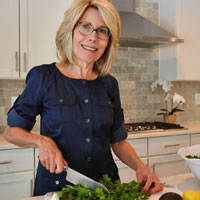Food for Thought
Stacy Fritz – Believe Big Advocate
Principal Owner – FIT2order, LLC
We Inspire Healthy Habits. Sedentary Solutions that Reduce the Health Hazards of Occupational Sitting

Paula Weinberg, JD, CNS, LDN, ONC
Integrative Oncology Nutritionist
Founder & Principal Owner – Healthspan Nutrition
Paula specializes in oncology nutrition, and is committed to empowering those affected by cancer with the most current evidence-based dietary and lifestyle changes.

Karen Shrum – NTM, ONC
Nutrition Therapist, certified Oncology Nutrition Consultant
Karen’s nutrition journey began early on. After obtaining her bachelor’s degree from Eastern Michigan University, she moved to Colorado and began taking nutrition classes. As the youngest in a family of eight Karen became a good observer, and after watching family members battle cancer, hypothyroidism, diabetes, and cardiovascular disease, she set out determined to find a better way.
Heather Isadora Dahm – Terrain Advocate
Nutrition Therapist
Thriving with active breast cancer since the fall of 2018, Heather continuously strives to cultivate a healthy body by embracing the rhythm of life with deep nutrition, sleep, knitting, spirituality, fun, movement, and community. Educated as a Terrain Advocate through MTIH and working toward certification as a Holistic Nutritionist (graduating May 2025), Heather is passionate about connecting with people, working with them to assess their terrain, and collaborating to find empowerment in their journey toward mind, body, and spirit wellness as she has done for herself.
Jen Nolan – BS, MS, ONC
Owner & Lead Oncology Nutrition Consultant
Jen offers oncology nutrition consults and nutrition genome analysis to the clients of Remission Nutrition.

Sara Stratton NTP, ONC
Oncology Nutrition Consultant
a lifelong health enthusiast, has spent over 20 years in healthcare, expanding access to traditional and functional medicine. Her personal pursuits as a recreational athlete and her focus on health optimization were challenged when she was diagnosed with breast cancer at 37. She combined modern medicine with holistic practices, emphasizing nutrition, exercise, mindset, and environment to build resilience during treatment.
Past Believe Big Nutrition Classes
Season 3
During this session, we took a 30,000-foot view of foundational nutrition principles with a deep dive into the three key macronutrients: protein, healthy fats, and carbohydrates—all vital components for healing and supporting your health journey, especially for those navigating cancer or survivorship.
Key Takeaways:
Protein:
- Essential for immune function, muscle mass, DNA replication, and hormone production.
- Focus on complete proteins (e.g., animal sources) or combine plant-based options (e.g., rice and beans) for completeness. Quality matters! Choose pasture-raised, wild-caught, or organic whenever possible.
Healthy Fats:
- Vital for cell membrane health, vitamin absorption, and reducing inflammation.
- Prioritize omega-3 fatty acids (e.g., olive oil, flaxseed, fish) and reduce omega-6-heavy oils (e.g., vegetable or canola oil). Avoid processed fats and instead choose whole food fats like nuts, seeds, and avocados.
Carbohydrates:
- The primary source of vitamins, minerals, and fiber.
- Choose nutrient-dense, whole food carbohydrates like vegetables and whole grains over processed/refined options. Be mindful of balancing starchy carbs with non-starchy vegetables.
🔗 Resources Mentioned:
- Continuous Glucose Monitors (CGMs) like Libre 3 to personalize blood sugar responses.
- Cronometer app: A free nutrition tracking tool to help monitor protein, fat, carb intake, and micronutrients.
- Chris Beat Cancer Podcast (Olive Oil episode recommended!)
- Dirty Dozen List (for choosing which produce to buy organic)
In this session, we shared:
✔️ How to find clean drinking water while traveling
✔️ The best portable snacks to stay healthy on the go
✔️ Tips for making better restaurant choices
✔️ Must-have travel essentials for a smooth and healthy trip
🔗 Resources Mentioned:
- Clearly Filtered Travel Water Bottle Removes over 99.99% of 220+ contaminants, including heavy metals, chemicals, and microplastics while preserving beneficial minerals. Ideal for urban use and travel.
- GRAYL GeoPress Water Purifier Bottle – Filters out viruses, bacteria, protozoa, and heavy metals. Designed for outdoor enthusiasts, backpackers, and international travelers with a fast filtration process.
- LifeStraw Go Water Filter Bottle – Features a two-stage filtration system that removes bacteria, parasites, and microplastics while improving water taste. A great choice for hiking and everyday travel.
- Natural Action Portable Water Filter – www.naturalaction.com
- Believe Big Podcast Episode on Non-Toxic Homes
We kicked off the new year with an eye-opening discussion on decoding nutrition labels, led by the incredible Paula Weinberg, an oncology nutritionist from Healthspan Nutrition.
Many of us find food labels confusing, but understanding them is key to making healthier choices, especially for those on a healing journey. Here are 3 major takeaways from the webinar:
 Avoid trans fats at all costs – Check labels for “partially hydrogenated oils” and steer clear!
Avoid trans fats at all costs – Check labels for “partially hydrogenated oils” and steer clear!
 Watch out for added sugars – Even in “healthy” foods like yogurt, added sugars can sneak in. Aim for zero added sugars whenever possible.
Watch out for added sugars – Even in “healthy” foods like yogurt, added sugars can sneak in. Aim for zero added sugars whenever possible.
 Protein, fiber & healthy fats matter – A balanced meal includes at least 20-30g of protein, plenty of fiber, and good fats like olive oil, nuts, and avocado.
Protein, fiber & healthy fats matter – A balanced meal includes at least 20-30g of protein, plenty of fiber, and good fats like olive oil, nuts, and avocado.
During the session, we also explored the hidden truths behind food packaging and marketing tricks. If you missed it or want to revisit the insights, you can watch the full replay below.
Additionally, here are some key resources we shared during the webinar:
 How to Read a Nutrition Label –
How to Read a Nutrition Label –  Book: “Nutrition Facts: The Truth About Food” by Karen Frazier
Book: “Nutrition Facts: The Truth About Food” by Karen Frazier
 A Guide to Healthy Fats & Oils –
A Guide to Healthy Fats & Oils –  “Know Your Fats: The Complete Primer for Understanding the Nutrition of Fats, Oils, and Cholesterol” by Mary G. Enig, Ph.D.
“Know Your Fats: The Complete Primer for Understanding the Nutrition of Fats, Oils, and Cholesterol” by Mary G. Enig, Ph.D.
Dive deep into the world of nutrition as we explore various resources, both free and paid, to help you navigate your nutritional needs effectively. Whether you’re looking for individual advice or group support, this session covers essential topics like customized nutrition plans, the importance of diet types like keto and Mediterranean, and how to utilize local and reliable sources for your nutritional journey. Discover how to harness the power of nutrition in your healing journey with insights from experts and engaging community questions.
Recipes and Resources Shared
Recipes:
- Bone Broth Recipe: A rich source of collagen and nutrients, tailored for immune and digestive health.
- Butternut Squash Soup: A seasonal favorite, balancing flavor with essential macros.
- Curried Cauliflower Soup: A flavorful, nutrient-packed option for fall and winter.
- Bone Broth Cacao: A unique and comforting blend of bone broth and cacao for a healing treat.
Resources:
- Integrative Oncology Nutrition: Remission Nutrition
- Healthy food sourcing: Thrive Market and EWG’s Clean Fifteen & Dirty Dozen
- Kitchen tools: Vitamix blender (contact Believe Big for a discount!)
Recommended books:

The Importance of Phytonutrients for Angiogenesis
Quercetin – antioxidant, anti-tumor, and anti-inflammatory activity. Even with low dosages, similar to what is found in the daily diet, quercetin inhibits proliferation by stopping the cancer’s cell cycle. Food Sources: onions, garlic, apples, celery, Brussels sprouts, arugula, cabbage, kale.
Baking, sautéing, roasting onions increases quercetin content.
Apigenin – anti-inflammatory, antioxidant, and anti-carcinogenic properties. It induces apoptosis of various cancer cell lines. Food sources: fresh parsley, celery, basil, oregano, and chamomile tea.
Luteolin – cancer cell apoptosis, and cell proliferation, metastasis, and angiogenesis inhibition. It sensitizes cancer cells to therapeutic-induced cytotoxicity through suppressing cell survival pathways. Food sources: celery, green peppers, olive oil, peppermint, thyme, rosemary, oregano.
**Celery is rich in luteolin, apigenin, kaempferol, and quercetin. • Eat celery within 5 to 7 days a week as research has found that celery begins to lose antioxidants rapidly.
Heresperitin induces apoptosis, inhibits cell replication, and inhibits angiogenesis and metastasis. Food sources: lemon juice, lemon, orange and fresh pomelo juice.
Resources:
1. Rasa Coffee- https://wearerasa.com
2. Base Culture Keto Bread- https://baseculture.com/
3. Beneficial Bakery- https://thebeneficialbakery.com
4. Continuous Blood Glucose Monitors (CGM)- Glucose monitors are medical devices and fall under strict regulation. There are only two commercial manufacturers of devices: Dexcom and Abbott Labs FreeStyle Libre devices. Dexcom is expensive and not as easy to obtain, so consider a FreeStyle Libre 2 or 3.
They are available online- https://www.freestyle.abbott
5. Wholesome Yum (easy recipes with 10 ingredients or less)
The Salad dressing recipe: – 1 to 2 Tbsp of tahini – 1 to 2 Tbsp of apple cider vinegar – 1 Tbsp of olive oil – Salt to taste
Season 1
Why Does Food Matter
Food Quality
Whole Foods .vs. Processed Foods
Organic Vs Conventional/GMO
Carbohydrates
The GOOD the BAD and the UGLY
- Glycemic Index >
- What is fiber? >
- Phytonutrient – Elimination Diet >
- Phytonutrient Spectrum Checklist for Kids >
SUGAR
The GOOD the BAD and the UGLY Part 2
- Dr. Cowan’s Garden https://www.
drcowansgarden.com -
Farmer’s Juice (Greens only) https://farmersjuice.
com/products/greens-only-box
- Salt Sugar Fat: How the Food Giants Hooked Us by Michael Moss
- Sugar Nation by Jeff O’Connell Good Calories, Bad Calories by Gary Taubes
- The Case Against Sugar by Gary Taubes
- Dr. Mark Hyman’s Doctor’s Farmacy – episodes February 2 & 4th
- The Worst & Best Foods for Your Blood Sugar with Dr. Casey Means
- The Truth about Sugar Addiction & How it Affects Your Health
TOP CANCER FIGHTING FOODS
- Cancer Fighting Kitchen by Rebecca Katz
- Healing Spices by Aggarwal & Yost
- Eating on the Wild Side by Jo Robinson
- Cancer Free with Food by Liana Werner-Gray
- Foods that Fight Cancer by Beliveau & Gingras
ALCOHOL & CANCER

What is Metabolic Terrain?
KETO & CANCER
Books
To Juice or Not to Juice
-
- Use minimally
- Must be organic and all greens (no fruit)
- Celery juice for lowing oxidative stress
- Juiced fresh using a high-quality cold-pressed juicer without heat
- Farmers juice green (keto) is the best for store-bought.
- Add fat like 1-3 teaspoons of MCT oil to help absorb nutrients
- Consume with meal to help balance(not just a carbohydrate)
- Walk/exercise close to consuming
Juice
Jen Nolan’s Zippy Juice
- Typically more frozen with a lot of fruit
- Typically raw ingredients
- Typically higher calorie, higher fat, more ketogenic and more of a meal replacement
- Not as frozen or raw so good for someone who is going through cancer treatment
- Add Dr. Cowan’s greens powders to this and a protein powder such as Nutiva Hemp, a VERY high-quality egg white protein powder if appropriate or Pure Paleo plain flavored from Designs for Health. Amy Myers also sells a plain bone broth protein powder that is good
Resources
- Redmond
- Celtic
- Himalayan
Resources
- Eat, drink, and be mindful. Albers, S.
- The loving diet: going beyond paleo into the heart of what ails you. Flannigan, J.
- Mindful Eating by Jan Chozen Bays, MD
- Intuitive Eating by Tribule & Resch
- Fit to Live by Pamela Peeke, MD
- Body for Life by Pamela Peeke, MD
Resources
- How to test stomach acid:
- Mix 1/4 teaspoon of baking soda with 6 ounces of water and drink.
- Set a timerfor 5 minutes.
- You should belch within 5 minutes.
*If you do not, there is a chance your stomach acid is too low to properly break down food for nutrient absorption in your intestines.
Super foods for digestion:
- Prebiotic foods – leeks, asparagus, onions, garlic, ginger, Jerusalem artichokes
- Probiotic foods – sauerkraut, kombucha, kefir and kimchi
Recipe 1 – Liver Love Soup– 2 medium avocados
– 2 cups of filtered water
– 2 cups of organic chicken bone broth
– 3 Tbsp of lemon juice (1 med lemon)
– ½ cup fresh cilantro leaves
– 1 garlic clove, minced
– 1 tsp ground cumin
– 1 tsp dried basil
– 1 tsp dried thyme
– 1 tsp dried mint
– 2 tbsp. fresh parsley or 1 tsp dried parsley
– Salt and pepper to taste
– Heat bone broth, add all ingredients to blender, mix and enjoy.Recipe 2 – Golden Turmeric Latte – Download
Resources
- Access the PPT slides here
- Blue Moon Herbs (aka Rene Caisse Tea – They sell organic herbs)
- Just Tea (They sell both organic herbs & pre-made tea with no additives)
- A Nurse’s Herbal Tea (now shipping the premade tea and organic herbs worldwide)
- https://genuineessiac.com
- FB group: Essiac Tea for Cancer
- Book: Cancer Hates Tea: A Unique Preventive and Transformative Lifestyle Change to Help Crush Cancer
Resources
- Reduce Toxin Exposure
- Control your bubble and eliminate/reduce xenoestrogens/endocrine disrupters, parabéns, BPA, water chemicals, cleaning products, cooking products, pesticides, and yes alcohol.
- Unjunk January…or June
- Support your own detoxification system
- Toxins stored in fat cells
- 3-phase process – Fat soluble to water soluble to excretion
- Phases 1 and 2 happen in the liver
- EX Methylation and requirement of folate and B12
- Excretion via breath, sweat, urine and feces
- Love Your Liver Nutrition
-
- Start the day with lemon water. Remember to drink out of a glass container as lemon can promote plastic to leach chemicals into the water.
- Teas. Green Tea – Catechins enhance liver function. During the day or evening, enjoy dandelion and ginger teas which support your liver detoxification process. Dandelion contains flavonoids and terpenoids – These compounds benefit liver function
- Avocado – Helps produce glutathione – master antioxidant
- Garlic – Allicin aids in cleansing (see attached recipe)
- Walnuts – Good source of amino acid arginine, helping the liver detoxify ammonia
- Organic. Always consume organic produce to lessen chemical and pesticide exposure
- Consume cilantro, parsley, onions and ginger which support the liver’s ability to detoxify. Think chimichurri and pesto sauces.
Resources
Types – the 3 Amigos
- Saturated – Fully saturated and no carbon bonds
- Monounsaturated – Has one carbon bond
- Polyunsaturated – Has many carbon bonds
The body makes all of its own fatty acids, except for two that need to be supplied by the diet: the essential fatty acids omega-3 and omega-6.
Fats play a major role in our health:
- Hormone Production
- Lower Inflammation
- Strengthen the Immune System
- Brain Function
- Cellular Integrity
- Nutrient Transportation
Using Fat Therapeutically for Cancer
Rule #1: Eat Animal Fats
Eggs are a Multivitamin – B vitamins, like choline.
- vitamins A, D, and E
- antioxidants that support eye health
- Pasture-raised eggs are necessary. Commercially raised eggs are 19x higher in inflammatory omega-6 fatty acids
Fun Fat Fact – cod liver oil not only provides Omega-3s (EPA and DHA), but also has high levels of vitamin A and D, important fat-soluble nutrients.
Rule #2: Eat a Balanced Array of Fats
- 3 Amigos work better together. Balance consumption between all three
- Variety of both plant and animal fat
- Saturated – beef tallow actually increased apoptosis and decreased the amount of pre-cancerous cells in the colon
- Monounsaturated – EVOO-derived polyphenols were able to inhibit HER2 activity in cultured human breast cancer cell studies.
- The researchers concluded that phytochemicals in EVOO, such as lignans, may provide a safe way to target HER2 in breast cancer patients.
Polyunsaturated – Fish oil decreases inflammation in prostate cancer.
Fun Fat Fact – Lauric acid is a medium chain fatty acid with strong anti-viral and anti-cancer effects. Lauric acid is found in coconut oil, palm kernel oil, breast milk, and grass fed butter.
Rule #3: Eat Quality Fats
Avoid oxidation – the deterioration of a fat when exposed to oxygen, which can result in free radical damage.
Hydrogenated oils or polyunsaturated oils that are unstable include: • Canola Oil • Margarine • Vegetable Shortening • Vegetable Oils
Avoid brands, such as: • Earth Balance • Smart Balance • Crisco • I Can’t Believe It’s Not Butter!
Extra-virgin olive oil is the highest designation of olive oil and has oleic acid of not more than 0.8 g per 100 g.
- Cold-pressed means that no heat is added; high heats oxidize the oil. The olives are crushed in a mill to extract the oil.
- Choose: organic, cold-pressed, extra virgin
Rule #4: Cook with Correct Temperature
Saturated fats are not easily damaged or oxidized by heat, light, and air, due to their chemical structure.
- Saturated fats are the only fats that should be used for high-heat cooking.
- Do not overcook these oils past their smoke point – when it starts to release free radicals into food.
Best High Heat Fats
Butter and Ghee: – Smoke Point: 350° F butter; 485° for ghee – Coconut Oil or Red Palm Oil: – Smoke Point: 350° F –• Beef Tallow: – Smoke Point: 420° F –
Cooking wild salmon, eggs, or beef over 275 degrees Fahrenheit causes a significant decrease in omega-3 fatty acids.
- The most mutagenic agents formed in cooking are called heterocyclic amines, and they are commonly found in barbecued beef, chicken, and pork cooked at 392 degrees or above.
Myth: Eating dietary cholesterol (egg yolks) raises cholesterol levels in the blood.
- Fact: Only 25% of the cholesterol in our body comes from diet. The other 75% is produced in the liver.
- Fact: The body tightly regulates cholesterol production, so if we limit dietary cholesterol, the body will make more cholesterol internally.
- Fact: It is carbohydrates that increase our internal production of dietary cholesterol.
Myth: Fish are not the only source of omega3 fatty acids. Eating flaxseeds is sufficient to get high amounts of omega-3s.
- Fact: Flaxseeds are only high in one member of the omega-3 fats family, alpha-linolenic acid (ALA). 50% of the oils in flaxseeds are ALA.
- ALA is high in many foods, such as walnuts, chia, and purslane.
- ALA is the precursor to the development of the essential omega-3s, DHA and EPA, but there are many obstacles to converting ALA into these needed forms including nutrients and genetic predisposition.
Myth: Fish oil can substitute for eating fish.
- Fact: In terms of EPA and DHA, fish oil contains more than most could eat in a day. For example, 6 capsules of Jarrow MaxDHA has 1.5g of DHA, but you would have to eat 8.5 oz. of wild salmon in a day to get the same amount in whole-food form.
- Fish oil, however, is absorbed differently than whole fish. The journal, Lipids, April 2003) , found that levels of DHA after 6 weeks of salmon consumption were 9 times higher than those taking fish oil. The researchers hypothesized that whole fish fat is familiar to our bodies, thus, easier to absorb.
Myth: Eating fish is dangerous because of mercury toxicity.
- Fact: Studies on mercury exposure consistently ignore selenium’s role in preventing mercury toxicity.
- Mercury is harmful because it deactivates selenium-dependent enzymes (selenoenzymes), preventing brain oxidative damage.
- When fish have more selenium than mercury, it is protective against toxicity. Most fish have more selenium, with the exception of shark, tilefish, king mackerel, and swordfish.
Myth: Avoid saturated fats, such as butter or ghee.
- Fact: Butter is the only source of butyric acid, a short-chain fatty acid that:
1) Reduces inflammation in the colon.
2) Inhibits undifferentiated cell growth.
The skin is the largest organ in the human body and plays an important role in protecting us from the environment, regulating moisture, maintaining body temperature, synthesizing vitamin D, and supporting the immune system. As we age, the skin’s production of collagen, elastin, and hyaluronic acid decreases, making it more susceptible to damage, wrinkles, and sagging.
The main environmental factor responsible for skin damage is ultraviolet (UV) radiation from the sun, which can cause DNA damage and increase the risk of skin cancer. Sunscreens can help protect the skin from UV radiation, but not all sunscreens are equally effective.
Although sunlight is essential for producing vitamin D and has other health-promoting benefits, excessive exposure to UV radiation can be harmful. Proper sun protection includes wearing protective clothing, sunglasses, and using a “clean” sunscreen with SPF 30 or higher. It is also important to strike a balance between getting enough sun exposure for vitamin D synthesis and avoiding excessive exposure to reduce the risk of skin damage and skin cancer.
Note, some sunscreen ingredients, such as oxybenzone and octinoxate, have been found to be harmful to coral reefs and marine life- consider eco-friendly sunscreen options when spending time in the water.
Resources
- AnnMarie Skin Products: Highly Activated Skin Care With Ultra-Hydrating Ingredients, Derived Straight From Nature, That Delivers Real Results.
- Beautycounter Products: https://www.beautycounter.com
Code: cleanforall20 (first time users 20% off)
- Best Kid’s Sunscreens: https://www.ewg.org/sunscreen/best-sunscreens/baby-kids-sunscreens/
Season 2
Resources
3 Breath Techniques: Water, Wine (or Whiskey) and Coffee (easy way to remember them, not official names of each of the techniques)
- Water – Good for any time, up regulating and down regulating (balance, good for energy AND relaxation) https://youtu.be/8Iq3hHng_gM
- Wine/Whiskey – Good for sleep, reduces anxiety https://youtu.be/HHLzfpTSy7w
- Coffee – Good for energy, careful with this technique, it can make you feel agitated if you overdo it https://youtu.be/gp0LjlBe6cU
Resources
- Holiday E-Book: 12-days of fitmas, grinchmas face mask, holy night body scrub, twinkle mocktail, holiday roasted nuts download here >
- Essential Oils Nasal Inhaler >
Resources
- Set a one word intention or a theme to 2024
- Create a vision board to include what you want to invite into your life this year
- Consider revisiting the Terrain Quiz at www.remissionnutrition.com to see if your health ‘terrain’ needs a refresh.
Setting the Stage for Success:
- Eliminate plastics from your kitchen to reduce toxin exposure.
- Restock your pantry, fridge, and freezer with nutritious choices.
- Plan and prepare your meals in advance for stress-free healthy eating.
- Immerse yourself in positive influences through podcasts, books, and supportive communities.
Nutritional Tweaks:
- Question every food choice: Does it nourish you?
- Cut back on sugar, especially post-holidays, and try a two-week sugar detox.
- Focus on whole foods, complex carbs, and low-glycemic fruits like berries and apples.
- Track your carb intake for three days to gain insights into your eating habits.
- Explore the benefits of keto and intermittent fasting, and remember to hydrate
Join Remission Nutrition’s Community, The Nest:
- Dive into a supportive environment with monthly meetups for just under $50 a month.
- Engage in nutrition talks, create vision boards, discuss transformative books, and enjoy cooking sessions.
- Sign up by February 23rd to be a part of this nurturing community.
For more details and to sign up for The Nest, visit Remission Nutrition https://www.
Resources
We are grateful for your participation in yesterday’s Food 4 Thought session, “Eat, Move, Breathe, Love” As promised, we are including the resources that were discussed during the session.
“Healthier” Homemade Dark Chocolate Peanut Butter Cups
(Recipe credit: Christina Marsigliese and modified by Stacy Fritz)
Prep Time: 20 minutes
Set Time: 30 minutes
Servings: Makes 15 small cups
Ingredients:
Filling:
- ½ cup crunchy unsalted almond butter (organic)
- 2 tablespoons maple syrup (organic)
- ¼ – ⅓ cup fine almond flour
- ⅛ teaspoon sea salt
Coating:
- 7 oz dark chocolate (70%+ cocoa)
- 2 teaspoons coconut oil
INSTRUCTIONS
- Line a standard cupcake pan with paper liners, or place liners standing up on a baking tray.
- For the filling, stir together almond butter, maple syrup, ¼ cup almond flour, and salt until it forms a stiff paste. Add more almond flour if it is still too loose, then refrigerate for about 15 minutes until it is stiff enough to shape.
- Roll heaped teaspoons of the mixture into smooth balls then flatten them in your hands and shape them into little discs or patties with a diameter just slightly smaller than the base of your paper liners.
- Melt together dark chocolate and coconut oil until smooth over a double boiler or in the microwave. Spoon about a teaspoon of the melted chocolate into each cup, spreading to cover the base and pushing it slightly up the sides to form an edge. Place an almond butter patty into each cup and gently press down so that some chocolate comes up the sides. Spoon more chocolate over top to cover evenly. Sprinkle with sea salt and refrigerate until set.
Should you have any questions or wish to discuss any of the topics in further detail, please do not hesitate to contact stacy@believebig.org
Nourishing the Soul
The Role of Food in Emotional Well-Being
– Choosing Faith Over Fear
– Recognizing that Food IS Medicine
– Our Thoughts and Emotions Can Help Us Heal
:Jen Nolan, BS, MS, ONC
RESOURCE DISCUSSED:
The Nest. A membership. A space for community, learning and support. We call our Remission Nutrition family of clients, loved ones, colleagues and friends THE NEST. The Nest is a safe space filled with unconditional love, non-judgement, supportive listening, learning, sharing and hope. https://www.remissionnutrition.com/the-nest-membership
Resources:
PDF of Remission Nutrition Recipe Cards: Download PDF >
- LMNT Electrolyte Gummies
- Coconut Pancakes
Links below to share with friends or family that want to help you but maybe don’t have the time to cook the items best for your nutritional needs:
Butcher Box: https://www.butcherbox.com
Smoothies, Soup and Bowl Service: https://www.daily-harvest.com
Fruit/Vegetable Delivery Service: https://www.hungryharvest.net


